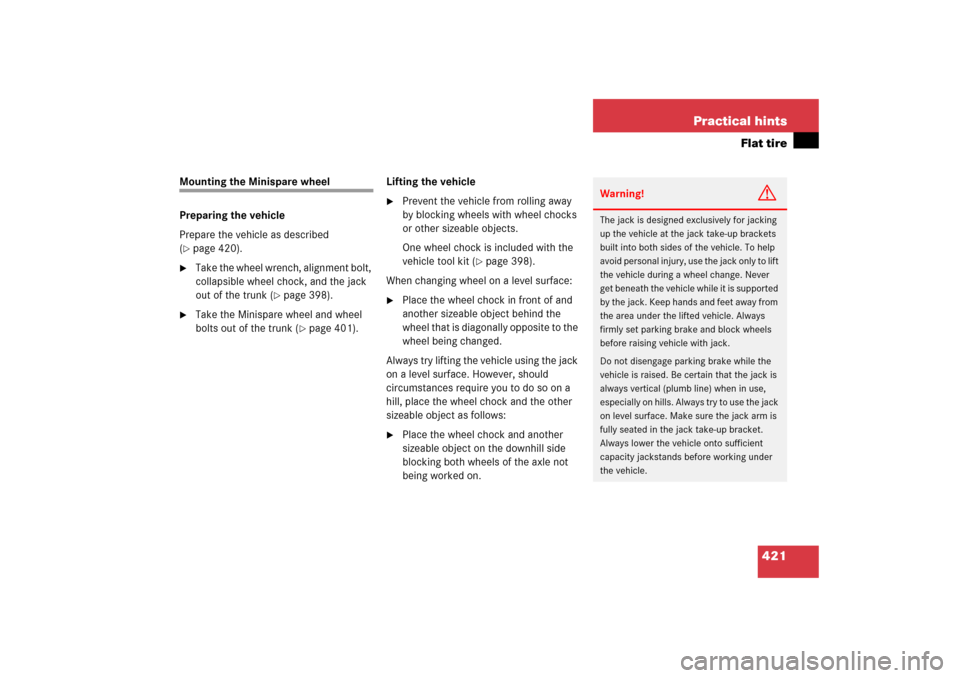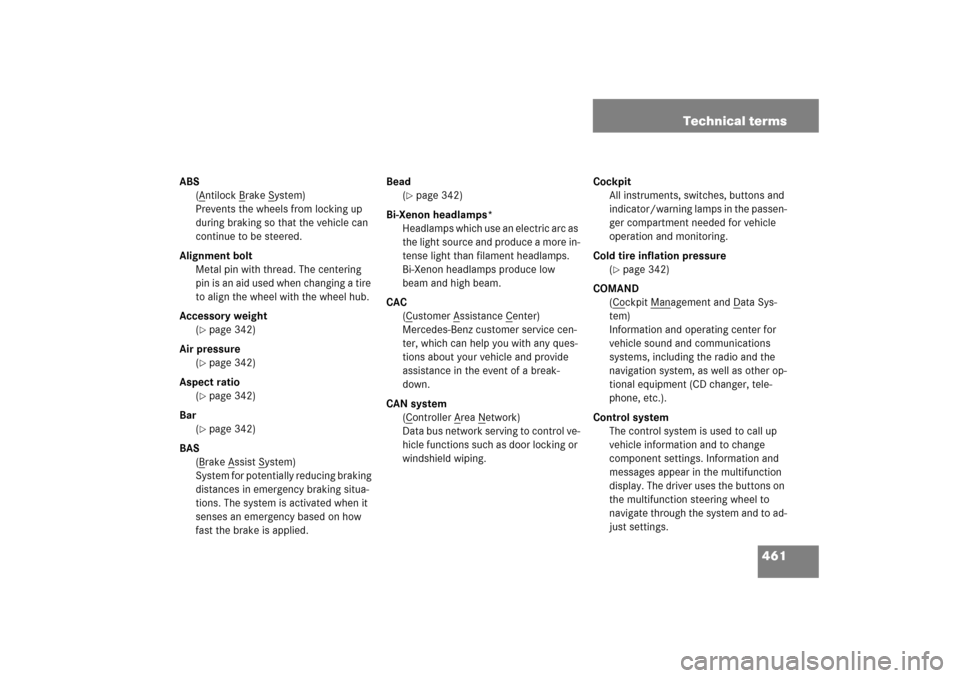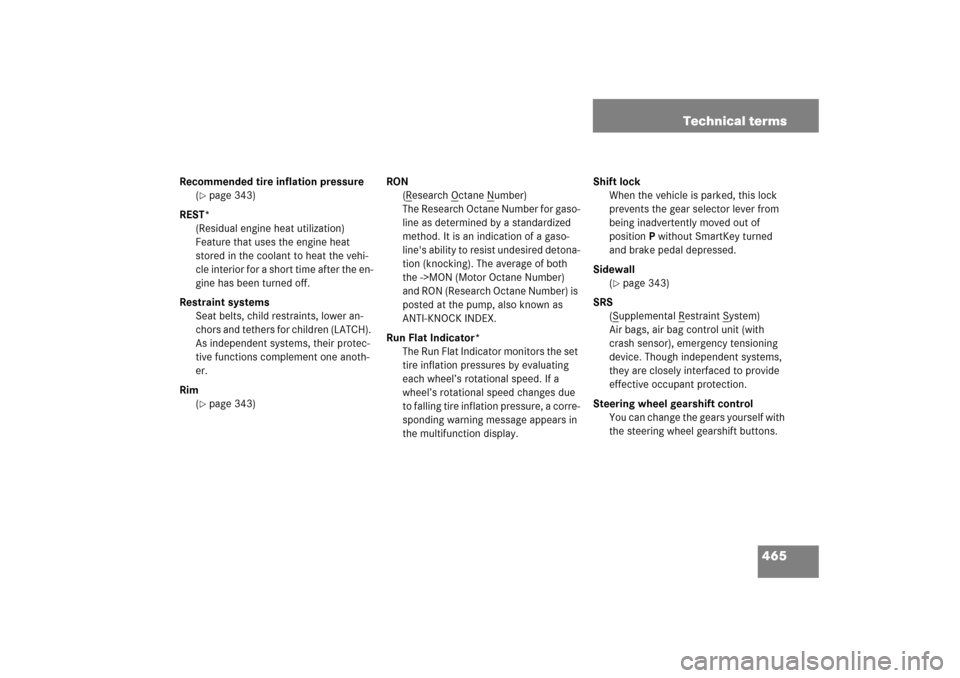Page 422 of 489

421 Practical hints
Flat tire
Mounting the Minispare wheel
Preparing the vehicle
Prepare the vehicle as described
(�page 420).
�
Take the wheel wrench, alignment bolt,
collapsible wheel chock, and the jack
out of the trunk (
�page 398).
�
Take the Minispare wheel and wheel
bolts out of the trunk (
�page 401).Lifting the vehicle
�
Prevent the vehicle from rolling away
by blocking wheels with wheel chocks
or other sizeable objects.
One wheel chock is included with the
vehicle tool kit (
�page 398).
When changing wheel on a level surface:
�
Place the wheel chock in front of and
another sizeable object behind the
wheel that is diagonally opposite to the
wheel being changed.
Always try lifting the vehicle using the jack
on a level surface. However, should
circumstances require you to do so on a
hill, place the wheel chock and the other
sizeable object as follows:
�
Place the wheel chock and another
sizeable object on the downhill side
blocking both wheels of the axle not
being worked on.
Warning!
G
The jack is designed exclusively for jacking
up the vehicle at the jack take-up brackets
built into both sides of the vehicle. To help
avoid personal injury, use the jack only to lift
the vehicle during a wheel change. Never
get beneath the vehicle while it is supported
by the jack. Keep hands and feet away from
the area under the lifted vehicle. Always
firmly set parking brake and block wheels
before raising vehicle with jack.
Do not disengage parking brake while the
vehicle is raised. Be certain that the jack is
always vertical (plumb line) when in use,
especially on hills. Always try to use the jack
on level surface. Make sure the jack arm is
fully seated in the jack take-up bracket.
Always lower the vehicle onto sufficient
capacity jackstands before working under
the vehicle.
Page 423 of 489
422 Practical hintsFlat tire1Wheel wrench�
On wheel to be changed, loosen but do
not yet remove the wheel bolts
(approximately one full turn with
wrench 1).
The jack take-up brackets are located
directly behind the front wheel housings
and in front of the rear wheel housings.2Jack
3Take-up bracket
�
Place jack2 on firm ground.
�
Position jack2 under take-up
bracket3 so that it is always vertical
(plumb-line) as seen from the side,
even if the vehicle is parked on an
incline.
�
Jack up the vehicle until the wheel is a
maximum of 1.2 in (3 cm) from the
ground. Never start engine while
vehicle is raised.Warning!
G
The jack is intended only for lifting the
vehicle briefly for wheel changes. It is not
suited for performing maintenance work
under the vehicle.�
Never start the engine when the vehicle
is raised.
�
Never lie down under the raised vehicle.
Page 462 of 489

461 Technical terms
ABS
(A
ntilock B
rake S
ystem)
Prevents the wheels from locking up
during braking so that the vehicle can
continue to be steered.
Alignment bolt
Metal pin with thread. The centering
pin is an aid used when changing a tire
to align the wheel with the wheel hub.
Accessory weight
(
�page 342)
Air pressure
(�page 342)
Aspect ratio
(�page 342)
Bar
(�page 342)
BAS
(Brake A
ssist S
ystem)
System for potentially reducing braking
distances in emergency braking situa-
tions. The system is activated when it
senses an emergency based on how
fast the brake is applied.Bead
(
�page 342)
Bi-Xenon headlamps*
Headlamps which use an electric arc as
the light source and produce a more in-
tense light than filament headlamps.
Bi-Xenon headlamps produce low
beam and high beam.
CAC
(Customer A
ssistance C
enter)
Mercedes-Benz customer service cen-
ter, which can help you with any ques-
tions about your vehicle and provide
assistance in the event of a break-
down.
CAN system
(C
ontroller A
rea N
etwork)
Data bus network serving to control ve-
hicle functions such as door locking or
windshield wiping.Cockpit
All instruments, switches, buttons and
indicator/warning lamps in the passen-
ger compartment needed for vehicle
operation and monitoring.
Cold tire inflation pressure
(
�page 342)
COMAND
(Cockpit M
anagement and D
ata Sys-
tem)
Information and operating center for
vehicle sound and communications
systems, including the radio and the
navigation system, as well as other op-
tional equipment (CD changer, tele-
phone, etc.).
Control system
The control system is used to call up
vehicle information and to change
component settings. Information and
messages appear in the multifunction
display. The driver uses the buttons on
the multifunction steering wheel to
navigate through the system and to ad-
just settings.
Page 466 of 489

465 Technical terms
Recommended tire inflation pressure
(
�page 343)
REST*
(Residual engine heat utilization)
Feature that uses the engine heat
stored in the coolant to heat the vehi-
cle interior for a short time after the en-
gine has been turned off.
Restraint systems
Seat belts, child restraints, lower an-
chors and tethers for children (LATCH).
As independent systems, their protec-
tive functions complement one anoth-
er.
Rim
(�page 343)RON
(R
esearch O
ctane N
umber)
The Research Octane Number for gaso-
line as determined by a standardized
method. It is an indication of a gaso-
line's ability to resist undesired detona-
tion (knocking). The average of both
the ->MON (Motor Octane Number)
and RON (Research Octane Number) is
posted at the pump, also known as
ANTI-KNOCK INDEX.
Run Flat Indicator*
The Run Flat Indicator monitors the set
tire inflation pressures by evaluating
each wheel’s rotational speed. If a
wheel’s rotational speed changes due
to falling tire inflation pressure, a corre-
sponding warning message appears in
the multifunction display.Shift lock
When the vehicle is parked, this lock
prevents the gear selector lever from
being inadvertently moved out of
positionP without SmartKey turned
and brake pedal depressed.
Sidewall
(
�page 343)
SRS
(Supplemental R
estraint S
ystem)
Air bags, air bag control unit (with
crash sensor), emergency tensioning
device. Though independent systems,
they are closely interfaced to provide
effective occupant protection.
Steering wheel gearshift control
You can change the gears yourself with
the steering wheel gearshift buttons.
Page 487 of 489

486 IndexVehicle loading
Cargo tie-down rings 268
Instructions 267, 320
Load limit 320
Roof rack* 262
Split rear bench seat 265
Terminology 342
Vehicle maximum load on the tire 344
Vehicle recovery services,
Stolen (Tele Aid) 286
Vehicle status message memory 151
Vehicle status messages 370
Vehicle system settings,
Control system 143
Vehicle tool kit 398
Vehicle washing 351
VIN 442, 466W
Warning indicators
Parktronic system*
(Canada only) 260
Warning sounds
Drivers seat belts 71
Parking brake 51
Parktronic system*
(Canada only) 260, 261
Seat belt telltale 71
Warranty coverage 10, 441
Washer fluid see Windshield washer fluid
Washer reservoir level 453
Washing the vehicle 351
Wear pattern, Tires 345
Weights, Vehicle 451
Wheel
Bolts 403
Change 421
Collapsible wheel chock 398
Removing 423
Spare 421
Tightening torque 424
Wrench 398Wheels, Sizes 447
Wheels, Tires and 317
Window curtain air bags 68
Windows see Power windows
Windshield
Cleaning 55, 356
Defogging 192, 202
Windshield washer fluid 316, 459
Message in display 397
Mixing ratio 459
Refilling 316
Reservoir level 453
Wiping 55
Windshield washer system 453, 459
Windshield wipers 53
Cleaning wiper blades 356
Replacing wiper blades 418
Winter driving 346
Block heater (Canada only) 347
Snow chains 347
Tires 346
Winter driving instructions 300
Winter tires 346
Wood trims, cleaning 358
Page:
< prev 1-8 9-16 17-24